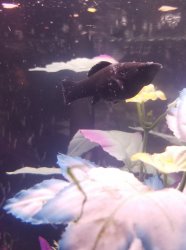I have had a slight problem with the Nitrite, nitrate and pH levels after adding some moss balls to my tank, they caused a huge spike in nitrite and nitrate levels, so I immediately removed them. I've done two 50% percent water changes a couple days apart. which it brought my levels down significantly. I also changed my filter which helped as well... ...My mother and I have kept tanks for years and have never added salt to an aquarium before or even heard about this. So I am a little on the fence about this. Any advice?
What do you mean by, you changed the filter?
If you replace filter materials you remove the beneficial filter bacteria that keep the ammonia and nitrite levels at 0. Without these bacteria you get ammonia and nitrite building up in the water and that will stress or kill fish. If the pH of the water is above 7.0, then any ammonia in the water becomes much more toxic and is going to do more damage to the fish.
As a general rule you do not replace filter materials. Instead you squeeze them out in a bucket of aquarium water, and when clean squeeze them out in a second bucket of aquarium water and then put them back in the filter.
The filter case and associated parts can be cleaned under tap water but you do not want to replace filter materials. The only exception to this is carbon (black granulated substance) and ammonia absorbing granules (like cream coloured gravel). These items should not be used except in an emergency.
Carbon absorbs chemicals and heavy metals from the water.
Ammonia absorbing granules absorb ammonia until they are full and then you get ammonia building up in the water and the filters start to cycle. A filter cycle is where the filter develops colonies of beneficial bacteria that eats ammonia and converts it into nitrite, and more bacteria eat the nitrite and convert it into nitrate. Nitrates get removed when you do water changes. Plants will also use some.
The only things you really need in a power filter is sponges. You can use ceramic beads/ noodles too if you like but sponges trap gunk and hold filter bacteria and don't need to be replaced.
--------------------------
If you have problems with tap water you could look at getting some tap water filters or a reverse osmosis unit to remove the chemicals and pollutants in the water. It might be cheaper than using bottled water.
--------------------------
Byron mentioned general hardness (GH) and if you want to keep livebearers (mollies, swordtails, guppies & platies), you need a GH above 250ppm for mollies and above 200ppm for the others.
If your water is soft (GH below 100ppm) you will have nothing but problems with livebearers.
If you are not sure on exact numbers, take a glass full of tank water and a glass of the bottled water you use to the local pet shop and ask them to test the water for you. Write the results down when they do the test. They should give test results like: ammonia 0.25ppm, nitrite 1.0ppm, nitrate 25ppm, pH 7.6, general hardness 120ppm (or it might be in degrees, eg: 4 dgh), and if possible but not essential, carbonate hardness (KH).
Bottled water should be aerated for 30 minutes or so before using it in an aquarium to get the dissolved gases back to normal.
You could also look at getting some different test kits. Liquid test kits are generally more accurate than paper strips. If you get test kits, check the expiry date on them and when you get them home, keep them in a cool, dry, dark place. I kept mine in a plastic container on the bottom shelf in the fridge.
Make sure children and animals can't get to the test kits because the chemicals the use are pretty toxic.
Wash your hands and rinse the test phials out after using them.
--------------------------
Salt is readily used in aquaculture to treat minor fungal, bacterial and protozoan infections in fish grown for human consumption. It reduces stress in fish (as long as it's not overdosed) and is a safer alternative to the chemicals sold in pet shops. Most of the chemicals used to treat aquarium fish are extremely hazardous and some like Malachite Green are carcinogenic. Fish that are farmed for human consumption must not be treated with any chemicals because the chemicals can remain in the fish and poison anything that eats the fish. So salt is used to treat fish instead of chemicals.
You can use any sort of non iodised salt including: rock salt, sea salt, swimming pool salt or aquarium salt. Aquarium salt is usually rock salt that has been repackaged.


